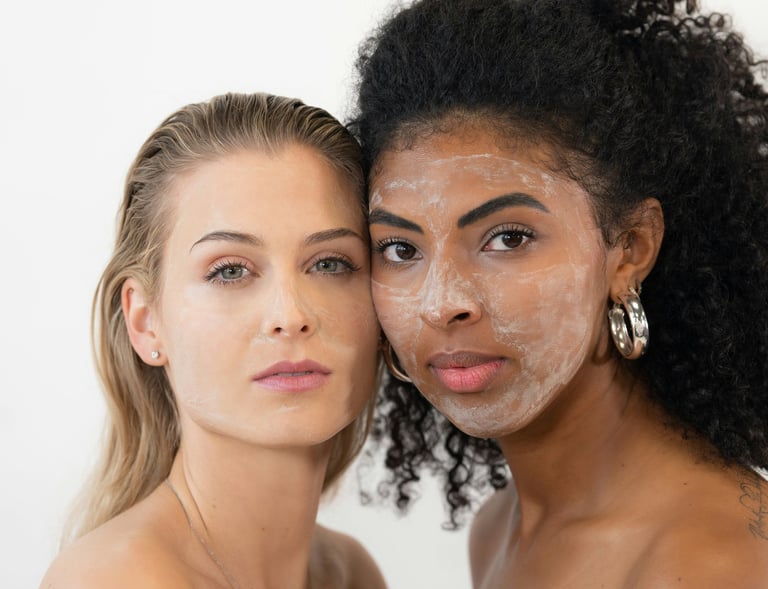Sensitive Skin vs. Reactive Skin — What’s the Difference and How to Treat Them?
Let’s be honest — skincare labels love throwing words at us. “For sensitive skin.” “Fragrance-free for sensitive types.” “Gentle for reactive skin.” But wait — is there a difference between sensitive and reactive skin? Or are brands just making up words now? Spoiler: they’re different. Knowing which one you have can help you avoid skincare drama, wasted money, and unnecessary flare-ups. Let’s break it down in the chillest, most helpful way possible. No jargon, no judgment.
1. First Things First — What Is Sensitive Skin?
Sensitive skin is a skin type. That means it’s part of your skin’s nature — just like dry, oily, or combination.
If you have sensitive skin, your skin tends to:
Turn red easily
Feel tight or uncomfortable after cleansing
React to new products with stinging or itching
Dislike fragrance or essential oils
It’s not always inflamed or irritated, but it can become reactive when triggered by harsh products, weather, or stress.
Think of sensitive skin as a quiet kid in class — calm most of the time, but will speak up if things get loud or confusing.
2. Okay, So What Is Reactive Skin Then?
Reactive skin isn’t a skin type — it’s a skin condition. It means your skin is currently inflamed or upset. Anyone, no matter their skin type, can experience it.
When skin is reactive, it might:
Burn, sting, or itch after applying a product
Turn red or blotchy in patches
Peel or break out in hives
Feel hot or extra sensitive to touch
Reactive skin is like a short fuse. It’s what happens when your skin’s protective barrier is compromised — kind of like walking barefoot on hot pavement. You’re gonna feel everything.
3. How to Tell Which One You’re Dealing With
Is it a long-term thing?
→ Sensitive skin: Yes
→ Reactive skin: No (usually temporary)Is your skin always easily irritated?
→ Sensitive skin: Sometimes
→ Reactive skin: Yes, very easilyDo products often trigger flare-ups?
→ Sensitive skin: Occasionally
→ Reactive skin: Almost alwaysDoes your skin feel hot, itchy, or stingy?
→ Sensitive skin: Sometimes
→ Reactive skin: FrequentlyIs your skin barrier likely damaged?
→ Sensitive skin: Maybe
→ Reactive skin: Most likely
You might have sensitive skin and then become reactive. Or you might just be going through a temporary reactive phase from a new retinol, too much exfoliation, or even a cold wind snap.
4. What Causes Each?
Common Causes of Sensitive Skin:
Genetics (thanks, Mom and Dad)
Fair, thin, or dry skin
Skin conditions like rosacea or eczema
Environmental stress (pollution, sun, wind)
Common Causes of Reactive Skin:
Overuse of actives (acids, retinol, vitamin C)
Harsh exfoliants or alcohol-based products
Allergic reactions
Barrier disruption (e.g. skipping moisturizer)
5. The Golden Rule: Fix the Barrier First
No matter what you're dealing with, the barrier is where healing starts. Your skin barrier is like a brick wall — when it’s damaged, everything leaks out (moisture) and everything gets in (irritants).
So how do you fix it?
Stop all active ingredients for a few days
Use gentle cleansers
Moisturize like it’s your job
Stick to short ingredient lists
★ Try: this creamy, non-foaming cleanser that doesn't strip or sting.
★ Try: this barrier repair moisturizer with ceramides and fatty acids.
★ Try: this soothing serum with panthenol and madecassoside.
6. Sensitive Skin Routine (Keep It Simple, Always)
AM Routine:
Gentle cleanser
Hydrating mist or toner
Barrier-repair moisturizer
Mineral-based sunscreen
PM Routine:
Same gentle cleanser
Hydrating serum (optional)
Rich but non-clogging moisturizer
★ Try: this mineral sunscreen with no white cast — great for sensitive types.
★ Try: this simple hydration serum that plays well with everything.
7. Reactive Skin Recovery Routine (The Skin Fast)
The trick with reactive skin is not to do more — it’s to do less.
For 3-5 days:
Cleanse once daily (evening only)
Moisturize twice daily
Skip serums, acids, and exfoliants
Avoid heat, spicy foods, and long showers
★ Try: this ultra-basic balm that feels like a hug on angry skin.
★ Try: this healing ointment that locks in hydration without clogging pores.
8. Ingredients That Help (and Ones That Hurt)
Ingredients to Look For:
Ceramides
Panthenol
Niacinamide (low concentration)
Allantoin
Beta-glucan
Centella asiatica (Cica)
★ Try: this toner with centella and green tea to calm skin post-flare.
Ingredients to Avoid (for now):
AHAs, BHAs, PHAs
Retinoids
Fragrance
Essential oils
Harsh scrubs
9. Can You Still Use “Actives” If You’re Sensitive?
Yes — but with caution. Sensitive skin can still benefit from ingredients like:
Azelaic acid (anti-inflammatory + acne help)
Low-dose niacinamide (barrier support + brightening)
Encapsulated retinol (gentler than traditional)
Introduce them one at a time, slowly, and always buffer with moisturizer.
★ Try: this beginner-friendly azelaic cream that tackles bumps and redness.
Final Thoughts: You Know Your Skin Best
Sensitive and reactive skin don’t have to feel like a mystery. Once you know which one you’re working with, it’s easier to treat your skin with patience, not panic.
Remember: fewer products, gentler formulas, and more moisturizer are always the move when your skin is upset. You don’t need a 10-step routine — just a little kindness and the right ingredients.


Glow is an Attitude
© 2025. All rights reserved